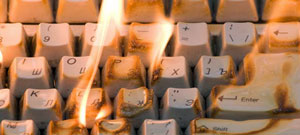 |
The global digital divide between those who are wired and those who are not is mirrored within Nepal. Affordability and accessibility issues have kept large sections of the population out of reach of the Internet. The digital divide, in fact, is just an extension of the income divide and education divide in Asia's most unequal country.
However, things are changing fast. The number of Facebook users in Nepal has crossed 1.4 million and is growing fast, there has been a sudden surge in Twitter accounts among Nepalis, and more and more people are reading news online. Many of the five million or so Nepalis who live and work abroad are hooked up to social media so they can keep in touch with home.
The Nepali media has so far not been affected by the migration of eyeballs to online sites, although print is suffering from advertisers moving to tv. But as the number of people getting news on PCs, laptops and smart phones increases, paper media will shed readers in the coming years. The new media is born, but the old is not dead yet.
Into this transition has arrived social media: blogs, email groups, online media, Facebook, Twitter, YouTube and what-have-you. Like it or not, this is going to affect politics because the young middle-class is getting wired in increasing numbers. A roundtable on social media organised this week by Himalmedia heard that more than half of Nepal's population is under 21. One way to look at this is as an alarming demographic bulge, but it also has huge political implications and opportunities. However, political parties and most leaders seem to be behind the curve in understanding new media even though it is going to have an increasingly important role in future elections.
For now, social media is a free-for-all. It is still dominated by the personal, but is increasingly being used as a political platform by citizens to air their views. It is in this dynamic, interactive and instantaneous public cyber-sphere that opinions are increasingly being made and spread. News of the Maoist split spread right across Nepal and to the diaspora through Twitter and Facebook, long before it "broke" on mainstream media sites.
But, as with all media there are the good, the bad and the ugly. At a time when the mainstream press is being co-opted, coerced or bought off by political parties not known for their adherence to democratic and free press values, social media holds out the hope of keeping the democratic space open.
The Internet is a double-edged sword. Just as it can help mobilise pro-democracy uprisings, its very freedom also provides a forum for those against freedom. Not just in Nepal but across the world, social media instead the levelling the playing field and being a marketplace of ideas, fragments society into thought ghettos. Instead of building bridges, it fosters echo chambers for corrosive dialogue.
Nepali language social media, instead of bringing society together has turned increasingly into a carrier of hate speech across ethnic lines. Racism, intolerance, incitement to violence and open threats characterise many of the postings on social media sites. They range from absurd biological determinism to support for supposed superiority of certain castes, to vitriolic postings that resemble anti-Semitic rhetoric elsewhere.
This may be a way to let off steam, dissipate anger, and Nepal's strong inter-ethnic bonds may be able to withstand the onslaught, but it does have the potential to devastate social harmony and take communal ties to breaking point.
Fortunately most Nepalis, wired or otherwise, value peace and harmony and want grievances addressed without violence and conflict. This silent majority must speak out and interact more on social media to drown out the voices of hatred and racism.
Read also:
Cybersphere
Digital multiply, RUBEENA MAHATO
The silent majority with moderate views need to counter hate speech on social media


